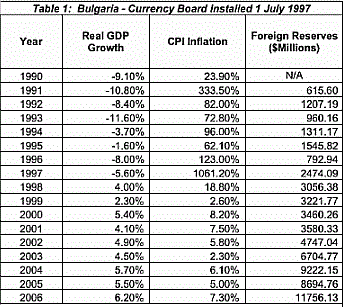
In 1997, Bulgaria and Bosnia and Herzegovina, which is commonly known as Bosnia, introduced currency board systems on July 1 and August 11, respectively. With a currency board system, a monetary authority issues a domestic currency that is freely convertible into an anchor currency at a fixed rate. Confidence in the domestic currency is established because the monetary authority must hold foreign reserves to fully cover the domestic currency that is issued.
Prior to the introduction of their currency board systems, both Bulgaria and Bosnia were in bad shape. Bulgaria had defaulted on its international debt, narrowly escaped a revolution in late 1996, and was battling hyperinflation (a rate of inflation per month that exceeds 50 per cent) that had virtually wiped out its banking system and sent the real economy into a free fall.

The newly independent Bosnia and Herzegovina had just come out of a bloody civil war, one that had disrupted and displaced most of the population, destroyed 18 per cent and damaged 60 per cent of the housing stock, and covered much of the territory with landmines. Its economy was in shambles, declining to about 20 per cent of its 1990 level. With the exception of the German mark, the other three currencies in circulation — the Bosnia and Herzegovina dinar, the Croatian kuna, and the Yugoslav dinar — were not freely convertible and were very unstable.
In both Bulgaria and Bosnia, I had an opportunity to play a role in designing and implementing their currency reforms. In 1991, I co-authored with Dr Kurt Schuler a monograph Teeth for the Bulgarian Lev: A Currency Board Solution. After its publication, I began making regular visits to Sofia to introduce the currency board idea to government officials and the public. The governor of the central bank set the tone for the 1991-95 period. He always asserted that the central bank had everything under control and had no need for currency board rules.
These conclusions were echoed in official circles until late 1996. But, as the hyperinflation and economic collapse gathered momentum, the official resistance to the currency board idea began to crumble. What forced it to completely collapse was a sharp turn in public opinion, as well as a revolt carried out in the streets of Sofia.
The public had lost all confidence in the government and the central bank. Instead, it embraced the currency board idea. As an indicator of the public’s support for the idea, consider that one of my books, Currency Boards for Developing Countries, had been translated into Bulgarian and reached the top of Sofia’s bestseller list in early 1997.
In March 1997, President Petar Stoyanov appointed me as his economic adviser. My immediate task was to draft a currency board law and assist in implementing it. On July 1, 1997, Bulgaria introduced a currency board law to govern its central bank.

In Bosnia, the currency board system was mandated by the Dayton/Paris Treaty (December 1995) which ended the civil war. To assist in the implementation of the new currency board system, I was invited to Sarajevo in December of 1996. And what a trip it was: military transport flights, armoured cars, bodyguards and other local oddities.
At the time of their installation, critics claimed that neither currency board would succeed because Bulgaria and Bosnia didn’t meet preconditions required for a successful currency reform. Those who peddle this precondition notion claim that a currency board is unlikely to be successful without solid economic fundamentals, adequate reserves, fiscal discipline, a strong and wellmanaged financial system and an adherence to the rule of law.
The preconditions argument falls into what I term the “95 % Rule”: ninety-five per cent of what is written about economics is either wrong or irrelevant. Just look at Tables 1 and 2. In the last decade, Bulgaria and Bosnia have experienced sustained economic growth, stable prices and a rapid increase in the demand for the currencies produced by their currency board systems (as reflected in the growth in foreign reserves).
Since their currency boards were established in 1997, the Bulgarian lev and Bosnian marka have been firmly fixed to their anchor currencies (the German mark and subsequently the euro). In consequence, the lev and marka have moved in lockstep with the euro against the US dollar — appreciating by almost 17 per cent relative to the greenback since the launch of the euro on January 1, 1999. The Bulgarian lev and Bosnian marka appreciation against the US dollar is a far cry from the performance of the Jamaican dollar. It has lost an incredible 47 per cent of its value against the greenback since January 1, 1999.

In 1995, I co-authored a monograph with Dr Kurt Schuler:Alternative Monetary Regimes for Jamaica. It was published by the Private Sector Organisation of Jamaica and remains available on the internet at: http://www.psoj.org/hanke.pdf. We concluded that, unless Jamaica adopted a currency board system (or simply replaced the Jamaican dollar with the US dollar), it would continue to be in the grip of excessively high real interest rates, a weak currency, relatively high inflation and anaemic economic growth.
It is clear that Jamaica’s economy would be in better shape today and the scourge of poverty would have been challenged if Jamaica had followed the sound money path taken by Bulgaria and Bosnia.
Prime Minister Golding, kindly review the data in Table 3.
Author Steve H. Hanke

0 responses on "Money: Bulgaria, Bosnia and Jamaica"